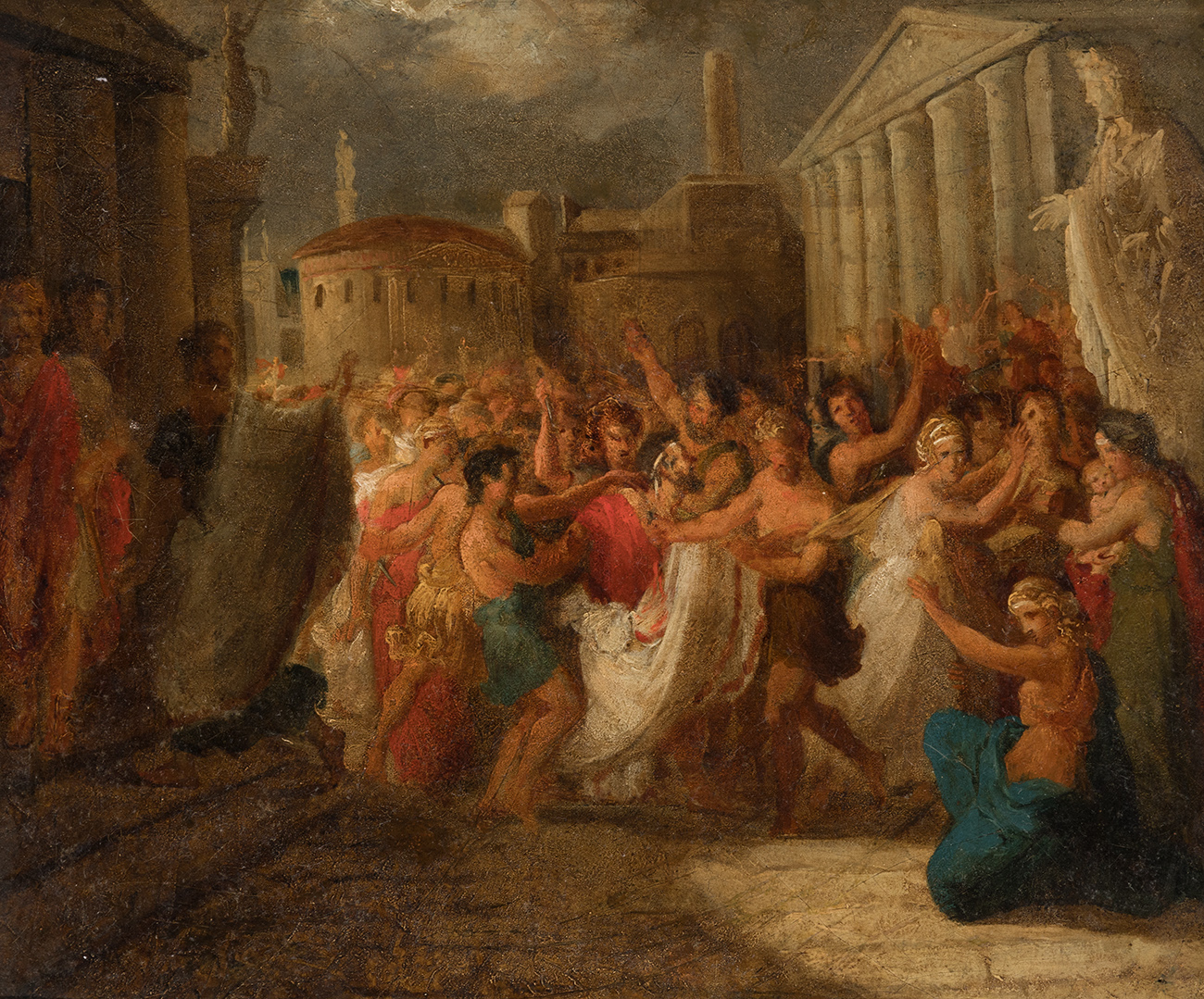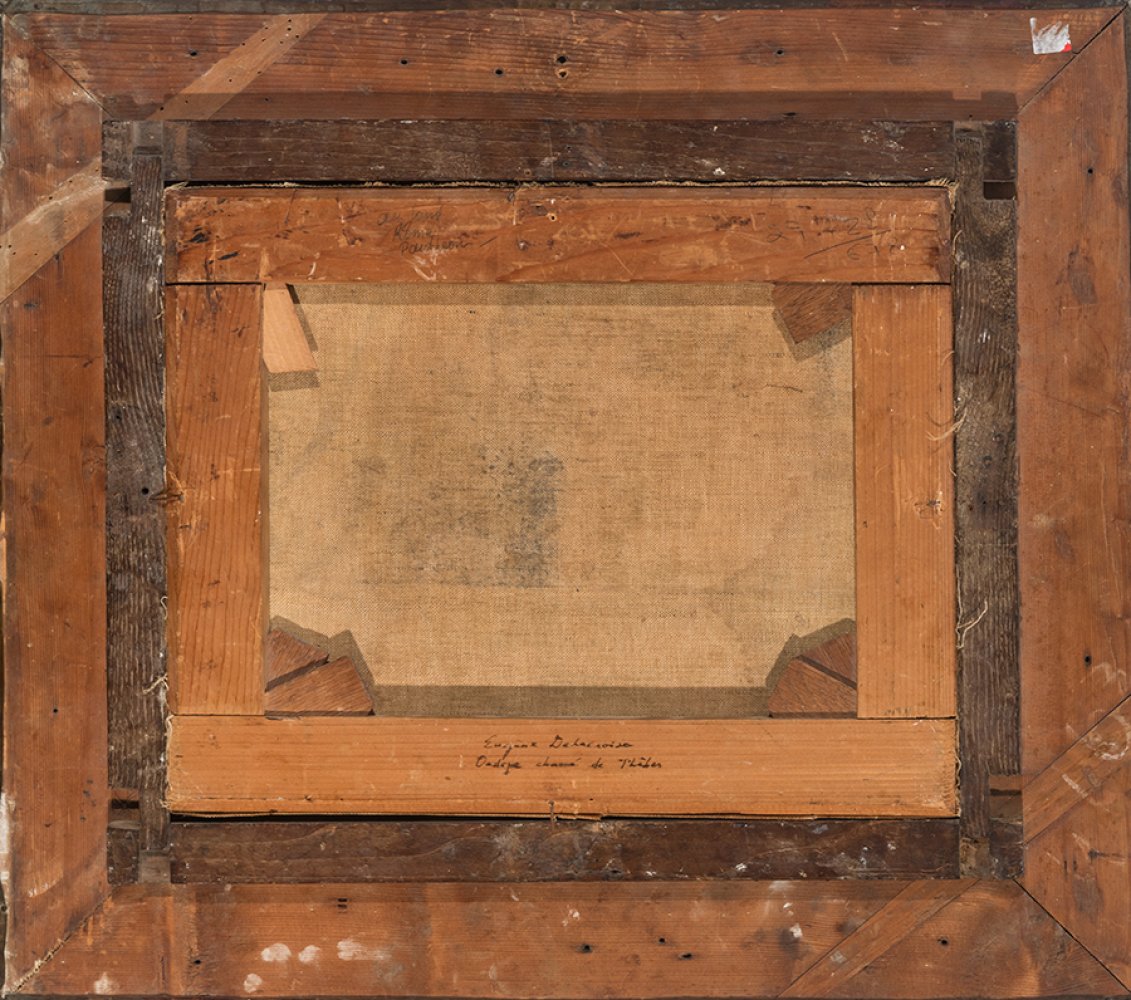60
French school; circa 1810."The Expulsion from Thebes".Oil on canvas. Re-coloured.Presents a 19th
1/3
Description
French school; circa 1810.
"The Expulsion from Thebes".
Oil on canvas. Re-coloured.
Presents a 19th century brass and bronze wooden frame.
Measurements: 32 x 38 cm; 52 x 58,5 cm (frame).
This work was formerly attributed to Ferdinand-Victor-Eugène Delacroix (Charenton-Saint-Maurice, France, 1798-Paris, 1863) . The painting depicts the sack of Thebes, a major event in the history of the city and of ancient Egypt in general. It effectively marks the end of Egypt's 25th Dynasty when Tantamani lost their main foothold in Egypt. The Kushites were permanently expelled a decade after the fall of Thebes, as none of Tantamani's successors would succeed in regaining the territories north of Elephantine. Durably weakened, Thebes peacefully submitted less than six years after the sack to a large fleet sent by Psametius to control Upper Egypt while it freed itself from Assyrian vassalage. The sacking thus allowed the rise of the 26th Dynasty, the end of the Third Intermediate Period and the beginning of the Late Period. Looting seems to have had a more general impact throughout the Ancient Near East, and is notably mentioned in the Book of Nahum as an example of the destruction and horror that can befall a city.
Nineteenth-century pictorial historicism, the main current at the time, linked to the Academies of Fine Arts. The term "historicism" (Historismus) was coined by the German philosopher Karl Wilhelm Friedrich Schlegel. Over time, what historicism is and how it is practised has taken on different and divergent meanings. Elements of historicism appear in the writings of the French essayist Michel de Montaigne (1533-1592) and the Italian philosopher GB Vico (1668-1744), and were more fully developed with the dialectics of Georg Wilhelm Friedrich Hegel (1770-1831), influential in nineteenth-century Europe.
"The Expulsion from Thebes".
Oil on canvas. Re-coloured.
Presents a 19th century brass and bronze wooden frame.
Measurements: 32 x 38 cm; 52 x 58,5 cm (frame).
This work was formerly attributed to Ferdinand-Victor-Eugène Delacroix (Charenton-Saint-Maurice, France, 1798-Paris, 1863) . The painting depicts the sack of Thebes, a major event in the history of the city and of ancient Egypt in general. It effectively marks the end of Egypt's 25th Dynasty when Tantamani lost their main foothold in Egypt. The Kushites were permanently expelled a decade after the fall of Thebes, as none of Tantamani's successors would succeed in regaining the territories north of Elephantine. Durably weakened, Thebes peacefully submitted less than six years after the sack to a large fleet sent by Psametius to control Upper Egypt while it freed itself from Assyrian vassalage. The sacking thus allowed the rise of the 26th Dynasty, the end of the Third Intermediate Period and the beginning of the Late Period. Looting seems to have had a more general impact throughout the Ancient Near East, and is notably mentioned in the Book of Nahum as an example of the destruction and horror that can befall a city.
Nineteenth-century pictorial historicism, the main current at the time, linked to the Academies of Fine Arts. The term "historicism" (Historismus) was coined by the German philosopher Karl Wilhelm Friedrich Schlegel. Over time, what historicism is and how it is practised has taken on different and divergent meanings. Elements of historicism appear in the writings of the French essayist Michel de Montaigne (1533-1592) and the Italian philosopher GB Vico (1668-1744), and were more fully developed with the dialectics of Georg Wilhelm Friedrich Hegel (1770-1831), influential in nineteenth-century Europe.
Auction Details
Shipping
T&Cs & Important Info
Ask seller a question
French school; circa 1810.
"The Expulsion from Thebes".
Oil on canvas. Re-coloured.
Presents a 19th century brass and bronze wooden frame.
Measurements: 32 x 38 cm; 52 x 58,5 cm (frame).
This work was formerly attributed to Ferdinand-Victor-Eugène Delacroix (Charenton-Saint-Maurice, France, 1798-Paris, 1863) . The painting depicts the sack of Thebes, a major event in the history of the city and of ancient Egypt in general. It effectively marks the end of Egypt's 25th Dynasty when Tantamani lost their main foothold in Egypt. The Kushites were permanently expelled a decade after the fall of Thebes, as none of Tantamani's successors would succeed in regaining the territories north of Elephantine. Durably weakened, Thebes peacefully submitted less than six years after the sack to a large fleet sent by Psametius to control Upper Egypt while it freed itself from Assyrian vassalage. The sacking thus allowed the rise of the 26th Dynasty, the end of the Third Intermediate Period and the beginning of the Late Period. Looting seems to have had a more general impact throughout the Ancient Near East, and is notably mentioned in the Book of Nahum as an example of the destruction and horror that can befall a city.
Nineteenth-century pictorial historicism, the main current at the time, linked to the Academies of Fine Arts. The term "historicism" (Historismus) was coined by the German philosopher Karl Wilhelm Friedrich Schlegel. Over time, what historicism is and how it is practised has taken on different and divergent meanings. Elements of historicism appear in the writings of the French essayist Michel de Montaigne (1533-1592) and the Italian philosopher GB Vico (1668-1744), and were more fully developed with the dialectics of Georg Wilhelm Friedrich Hegel (1770-1831), influential in nineteenth-century Europe.
"The Expulsion from Thebes".
Oil on canvas. Re-coloured.
Presents a 19th century brass and bronze wooden frame.
Measurements: 32 x 38 cm; 52 x 58,5 cm (frame).
This work was formerly attributed to Ferdinand-Victor-Eugène Delacroix (Charenton-Saint-Maurice, France, 1798-Paris, 1863) . The painting depicts the sack of Thebes, a major event in the history of the city and of ancient Egypt in general. It effectively marks the end of Egypt's 25th Dynasty when Tantamani lost their main foothold in Egypt. The Kushites were permanently expelled a decade after the fall of Thebes, as none of Tantamani's successors would succeed in regaining the territories north of Elephantine. Durably weakened, Thebes peacefully submitted less than six years after the sack to a large fleet sent by Psametius to control Upper Egypt while it freed itself from Assyrian vassalage. The sacking thus allowed the rise of the 26th Dynasty, the end of the Third Intermediate Period and the beginning of the Late Period. Looting seems to have had a more general impact throughout the Ancient Near East, and is notably mentioned in the Book of Nahum as an example of the destruction and horror that can befall a city.
Nineteenth-century pictorial historicism, the main current at the time, linked to the Academies of Fine Arts. The term "historicism" (Historismus) was coined by the German philosopher Karl Wilhelm Friedrich Schlegel. Over time, what historicism is and how it is practised has taken on different and divergent meanings. Elements of historicism appear in the writings of the French essayist Michel de Montaigne (1533-1592) and the Italian philosopher GB Vico (1668-1744), and were more fully developed with the dialectics of Georg Wilhelm Friedrich Hegel (1770-1831), influential in nineteenth-century Europe.
29th December - Old Masters
Sale Date(s)
Venue Address
Aragón 346, Barcelona
Calle Velázquez 7, Madrid
Carrer de Cirilo Amorós 55, Valencia
Barcelona
08009
Spain
General delivery information available from the auctioneer
Setdart offers Worldwide shipping
PICK UP IN ROOM: You can come and pick up your lots in our offices (Barcelona, Madrid or Valencia). At the moment of the withdrawal, you will be able to accept the current conditions of the lot by means of a document that you will sign.
YOU CAN SEND ANOTHER PERSON TO PICK UP: This person must present a signed authorization that you can find in our web page by accessing from BUY AT SETDART- LOGISTICS-DOWNLOAD AUTHORIZATION DOCUMENT. You can also send an e-mail with the requested data in AUTHORIZATION DOCUMENT to admin@setdart.com
Important Information
25% buyer´s premium
21% buyer´s premium at www.setdart.com









